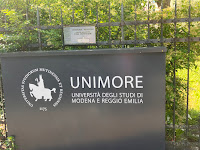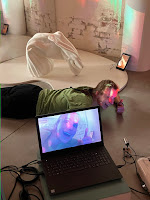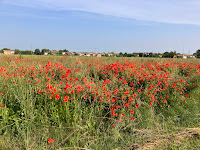Day 10: May 27
- Middle School Manzoni Valeria--at University for the class 2 students
- The Malaguzzi Center Tour
- The rest of the day
Middle School Manzoni Valeria--at University for the class 2 students
Valeria explained the high school system here. There are four routes, but a 5th path is more of a tech school.
- Engineering - more based on math, sciences, and technology Students go into university and need the scientific background
- Mechanics - focused on hospitality, design, etc. These students almost all go into jobs
- Classics - Greek, literature, etc. These students almost all go to uni and typically follow a more professorial route
- Languages - other than English, students study other languages, namely European. Both Valeria and Guilia did German and French. Students go into university and study an extra-European language: Russian for Valeria and Chinese for Guilia
- Technical- these are the trades, including informatics and marketing. Some students go into uni while others go into jobs
- The schools are collaborating with the university to invest more in science math, and overall STEM education overall, and they hope to continue such a path into high school. They want to increase female interest in STEM fields, and overall inclusivity in science and engineering education.
- The ten year collaboration of interdisciplinary projects allow students to be exposed to different content and disciplines, and make better informed decisions for next year as they complete middle school and determine a high school path.
- Of note is the desire for students to do math and science with creativity, to leave room for imagination. It makes me think a lot about what Dr. Gess has discussed in multiple classes about STEAM education, where creativity is a design process, and collaboration for interdisciplinary projects like this is a cornerstone.
- I was heavily reminded of the Reggio Approach during a PowerPoint on how these projects promote cognitive and creative value in metaphors and narration based on imagination, a notion that was reiterated during the tour of the Malaguzzi Center. I also liked how the projects encourage diverse stories that reflect the way students experience the world and re-elaborate what is known to reason about their processes and spark their imaginations.
Two of my favorite pieces of the presentation were the video shown, which highlighted different students and their work (sparking a lot of excitement from the students) and the one presentation we saw. The project students had done and presented while I was there helped students take an elaborate concept and a source of power that disturbs itself by going from one thing to another. The model gave students new meaning to the learning and helped them recognize what is around them, to respect the environment, and to work together and invent objects that could help them change the future.
The Malaguzzi Center Tour
The tour of the Malaguzzi center was quite interesting. Educators from all over the world can meet and discuss education, and holds multiple ateliers where students can collaborate. There are also different pieces of work on display.
- Metaphors on Children's Thoughts: This showed how students process what they see about the world. There were different examples on how students connect what they know with what they see, and with new experiences. I particularly enjoyed seeing how students take real items and draw a picture with it to give context to their imagination.
- Fantastic Binomial, by Gianni Rodari: This showed the origins of the grammar of fantasy, which fascinated me. I particularly noted how the information gave linguistic context to the conceptions and understandings deriving from students' imaginations, feeding into the notion of 100 languages of children.
- The technology area included the languages of gears and technology, and had some unique pieces of art.
- I didn't think I would be interested in the historical aspect, but I was proven wrong. Young childhood education in Italy was inspired by anti-facist movements of social justice following WWII. Infant schools started in 1963, but it wasn't until the 1980s when people began to explore projects of how children view their world. In 1994, Newsweek published information that pointed to Reggio Emilia as having the best preschools in the world. That provided the foundation for an international center to take shape.
- The ray of light atelier allows students to investigate rays, refraction, and other science behind light. There were some areas we could interact with, and I had some fun along the way.
The Rest of the Day
I was very glad to have time after lunch to work with the other grad students on our work. The time is what I had been expecting to have nearly every day, and was sorely needed. It was helpful that two of us are in 899a, two in 899b, and one is working on the IRB approval information. We were able to brainstorm, workshop, and help each other with multiple assignments and requirements.













Comments
Post a Comment